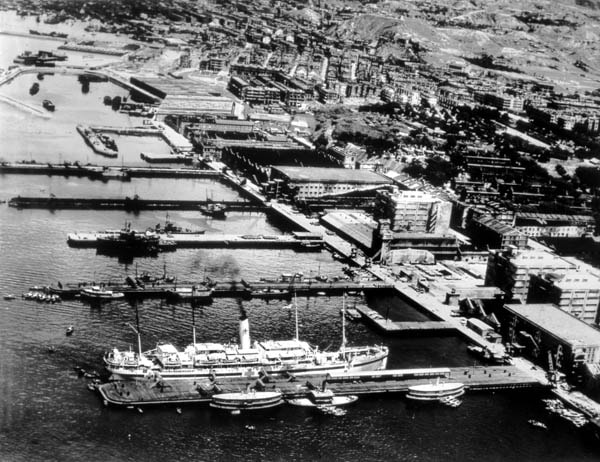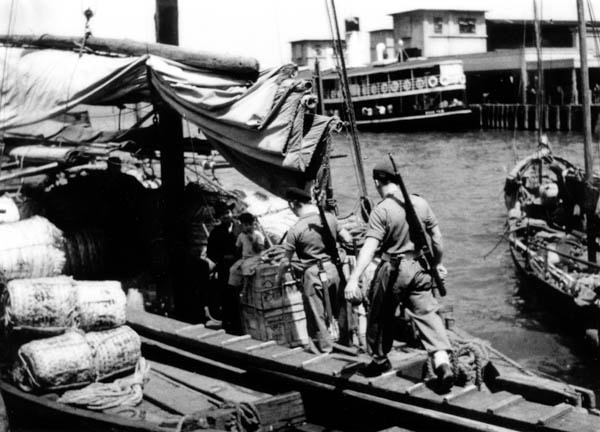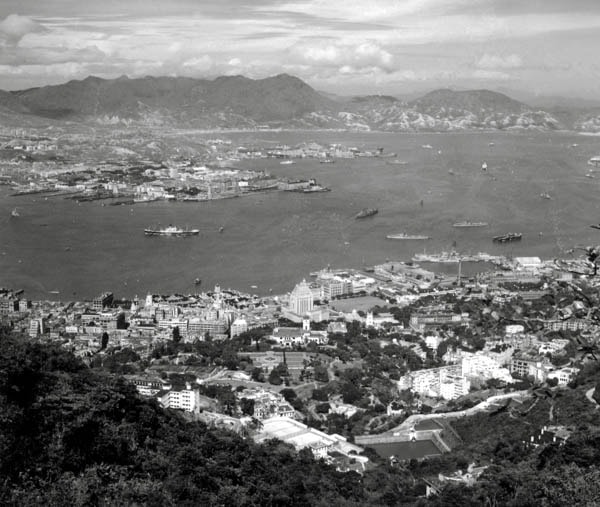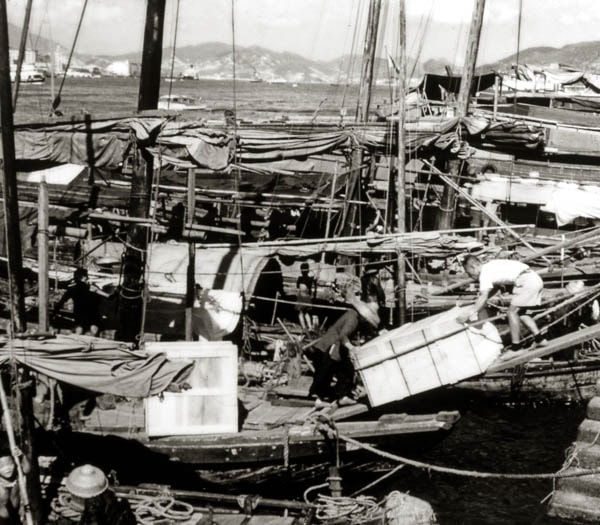On 15 August 1945, the Japanese Emperor proclaimed that Japan had unconditionally surrendered. The Royal Navy entered Hong Kong waters in late August as soon as it had assembled enough warships to secure Hong Kong. A fleet of 77 warships, including two battleships and an aircraft carrier, was stationed in Hong Kong a few days before the signing of the surrender document on 18 September 1945.[36] At least 66 Japanese ships of various types were abandoned in Hong Kong, almost all of them either damaged or otherwise deficient. The scrap ships were finally handed over to the Chinese Government in the late 1940s. [37]
Before the return of the Governor, Sir Mark Young, on 1 May 1946, Hong Kong was under the military administration of Admiral Cecil Harcourt of the Royal Navy. In order to restore Hong Kong to its former glory, lacking as it did money, food, coal, housing and labour, many urgent issues had to be resolved. The rehabilitation of the harbour topped the list of these urgent issues, as internal and external links mostly relied on sea transportation.[38]
Following the recommendations of Sir David J. Owen in 1941, the Harbour Master, James Jolly, while being imprisoned in Stanley Camp in February 1945, proposed to set up a Port Commission and to have the Harbour Department renamed the Marine Department. However, the department was still officially known as the Harbour Department until the renaming was finally approved in January 1948. According to his proposal, the commission was to be established to undertake the control and operation of major port functions such as conducting surveys and soundings, issuing licences to pilots, advising the Government on port issues, and executing approved development plans. The commission which was subsequently set up was presided over by the Director of Marine, while the Marine Department continued to be the port administrator.[39]
A number of committees related to port development, such as the Port Executive Committee, the Port Working Committee, the Port Consultative Committee, and the Port Administration Inquiry Committee were established immediately after the Royal Navy took over control of Hong Kong in late 1945. In fact, the British Ministry of War Transport suggested the gradual handover of the port from the military authorities to the civil government in three phases. As part of this process, the Port Executive Committee was formed to operate the port.[40]
A draft of the “Hong Kong Port Trust Ordinance” was tabled at the general meeting of the Port Consultative Committee in April 1946, proposing the establishment of a Port Trust.[41] A meeting of the Executive Council in December 1946, however, considered that the establishment of a Port Trust was not justified, and that all requirements for the administration and control of the port, including matters of long-term policy, could be adequately and satisfactorily met by the formation of a Port Committee.[42] The exorbitant expenses that would be involved were also a major concern against the establishment of the Port Trust. From the Harbour Department’s perspective, removing from the Department the work of the Ships Survey Office, the Shipping Master’s Office and the Marine Court would cause inconvenience to shipping, as well as leading to reduced efficiency and an increase in expenses. James Jolly, therefore, advocated that the Harbour Department be changed into the Marine Department, which would be responsible for the day-to-day working of the harbour.[43] With some modifications, the Port Committee was formed and started functioning in late 1946 as an advisory body on port development.
The Harbour Department used to be under the Director of Supplies, Transport and Industry before it began operating as an individual department after February 1946. Although the department made steady progress towards re-establishing itself, it was nevertheless not as effectively in control of the harbour as it had been in the pre-war years.
The offices under the original establishment of the Harbour Department, such as Principal Surveyor of Ships’ Office, Boarding Office, Junk Office, Mercantile Marine Office, Entry and Clearance Office, Lighthouse Section and Government Slipway (Yaumatei), operated well as soon as they returned to the supervision of James Jolly, who resumed his position as Harbour Master soon after the Royal Navy took control of the port of Hong Kong in September 1945.[44] To deal with the large number of sunken or derelict ships in the harbour, a Salvage Section was established in early 1947. Soon afterwards, the Ship Registry Office, the Marine Magistrate’s Court and the Drawing Office were functioning effectively as well.[45] A Reparations Claims Office was set up to deal with claims for loss of river steamers and small craft during the war. Up to mid-1947, registered claims amounted to over HK$20 million for 296 vessels.[46] To cope with such an extraordinarily heavy workload, the Harbour Department’s estimated budget was dramatically increased to HK$2,569,253 for 1946-47 (compared to HK$1,407,321 in 1941-1942), of which about 70% was related to provision for expenditure on coal and oil fuel for launches, the hire of tugs for lighthouse relief and repairs, and minor improvements and stores for launches and other boats .[47] The increase in budget, however, was still not adequate for the development of the whole department. An example was that until late 1947, at least 15 vessels in the service of the Harbour Department were on loan from various authorities such as the Ministry of Transport, the War Office and the Admiralty in Australia. Such a situation could also be found in other government departments due to the shortage of raw materials and building funds.[48]
Both short-term and long-term measures were employed to rehabilitate port facilities. For the immediate measures, the damaged wharves, main quays, reserved transportation areas, godowns, marine lots and dockyards along the shores of Kowloon and Hong Kong needed to be repaired urgently.[49] In 1946, the government spent HK$1.05 million on port reconstruction projects out of the total rehabilitation expenses of HK$13 million.[50] For future development, the government decided to survey and plan wharves and godowns for expansion and to purchase new equipment such as steam cranes, towing tractors, and stacking machines. For the sake of navigational safety, work was soon undertaken to reposition and install navigational aids and salvage shipwrecks.[51] The lights on Green Island, Cheung Chau, Yau Ma Tei typhoon causeway and Cape Collinson were the first to be re-established in early 1946.[52]
The shipping industry started to recover immediately after the Japanese surrender. A total of 14 ships were plying from Hong Kong to Macao, Guangzhou and a few other river ports in Guangdong, while over 30 companies were operating routes to China and overseas. The monthly number of vessel calls increased from 195 vessels totalling 413,834 gross registered tons in July 1946 to 477 vessels with a total gross registered tonnage of 667,935 in December 1947.[53] With the support of the shipping industry, 60% of the factories owned by Chinese merchants resumed business by late 1946, out of a total of more than 600 factories in the pre-war period.[54] The economic atmosphere, however, once again deteriorated in mid-1946 as the price of raw materials fluctuated greatly and as economic recovery in Europe proved agonisingly slow. The Sino-British Industrial Committee, Hong Kong, was established during this period. It helped both the shipping and trading industries to extend their trading routes significantly within the Pacific region. Despite competition from other countries in East Asia and South-East Asia, Hong Kong was able to reposition itself successfully in the postwar world by building on the foundation of industrialisation.[55]
Notes:
- [36]馬幼垣:〈與香港光復有關的兩個海軍問題〉,《靖海澄彊 ── 中國近海軍史事新詮》(台北:聯經出版社,2009),頁477-532。
- [37]Ibid., pp. 477-532.
- [38]Cecil Harcourt, ‘The Military Administration of Hong Kong’, Journal of the Royal Central Asian Society, 34.1 (January 1947), p. 18.
- [39]James Jolly, ‘Memorandum on the future administration of the port of Hong Kong’, 12 February 1945.
- [40]HKRS170-1-331, ‘Ministry of War Transport’, 1945-1947’, Ministry of War Transport - 1. Memorandum on ..... 2. Transfer of Responsibilities of Craft of ..... to Harbour Master, 14.09.1945 - 31.03.1947, Hong Kong Public Records Office, 35.
- [41]HKRS163-1-56, ‘Establishment of Port Trust’, Port Trust – Establishment of …10.1945-11.12.1946, Hong Kong Public Records Office, 35.
- [42]Ibid., 37.
- [43]CO129/618/7, ‘Report of the Port Administration Inquiry Committee’, pp.192-193.
- [44]See ‘Notice to Mariners (P). No. 1/45. Hong Kong – Information about condition of the Port’, in Hong Kong Government Gazette, 5 September 1945.
- [45]HKRS170-1-569-1, ‘Harbour Master Monthly Report’, Harbour Department 11.03.1946-07.07.1959. Hong Kong Public Records Office.
- [46]HKRS41-1-1782, ‘Losses of Hong Kong Government owned small craft through enemy action’, Losses of Hong Kong Government Owned Small Craft Through Enemy Action – Position as Regards…16.05.1946-10.06.1947, Hong Kong Public Records Office.
- [47]HKRS170-1-189, Estimates 1946-47, Harbour Department, 21.02.1946-25.09.1946, Hong Kong Public Records Office.
- [48]HKRS41-1-3353, ‘Vessels in the service of the Hong Kong Government owned by various Disposal Authorities’, Shipping – Vessels in the Service of the Hong Kong Government Owned by Various Disposal Authorities 23.05.1947-03.03.1953, Hong Kong Public Records Office.
- [49]C. R. Janvrin, ‘Report on rehabilitation of the port of Kowloon-Hong Kong on a short and long term policy’, 20 October 1945.
- [50]《復員的香港》(香港:中華出版社,1947)。
- [51]Janvrin, ‘Report on rehabilitation of the port of Kowloon-Hong Kong on a short and long term policy’.
- [52]HKRS170-1-569-1, ‘Harbour Master Monthly Report’, Reports – Harbour Department 11.03.1946-05.06.1947, Hong Kong Public Records Office.
- [53]Ibid.
- [54]《復員的香港》;王楚瑩:《香港工廠調查》(香港:南僑新聞企業公司,1947)。
- [55]劉蜀永:〈工業化的實現〉,《20世紀香港經濟》(香港:三聯書店,2004),頁163-187。






